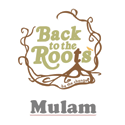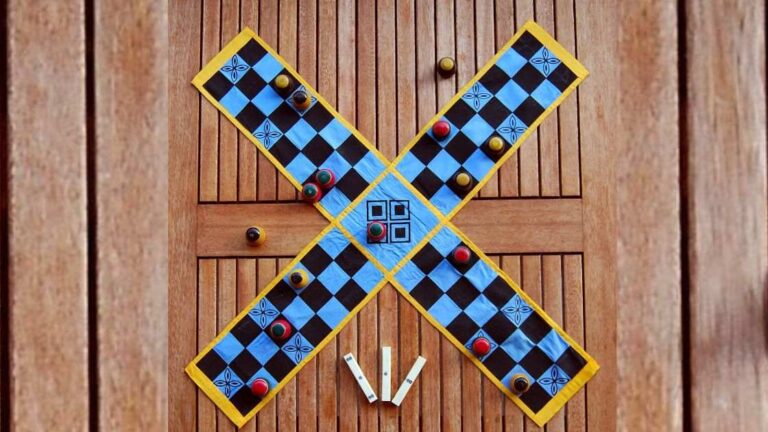Pachisi

Fig 1

Fig 2

Fig 3
Contents:- One game board; 4 sets of paws ( each set contains 4 pairs which are colored And Red. Yellow, Black. And Green dice. The game board has four arms joined at the sides of a central big square wish is “ Home” Each arm is made up of three rows and eight squares. we shall call the home arms of Red Yellow, Balck, and Green. Paws f Red – Arm, Yellow Arm. Black Arm. and Green arm Respectively.
Red paws go around the board Staring from to Red P AWS Similarly other paws start their journeys to home parts respectively. Given below is the path of Red Paws. Pachisi is a racing game in which two or four players can play.
Given here is a four-player game.
Fig 3 Shows the game board from the red point of view.
Some squares are sequentially numbered from 1 to 75. Other pawn sets and hence Red While others have been blackened
The numbering originates from the home arm of Red SquBelly; fares from 1 to 7 are collectively called Red,s Belly. The bellyis the private domain of one set of pawns where venture blackened squares in the Fig3 depict Belly of other pawn sets ans hence Red pawn cannot move from 1 to 75 sequentially and then to 8 and go down the belly to 1 and finally plunging into Home .-
1-2-3-……………………….73-74-75–8-7-6-5-4-3 2- 1 Home
Similarly, other pawns move around the board and come back to their respective home -arms and go down their Belly and into the home. The movement (anti-clockwise direction) is shown as an arrow in Fig.2
Initially, pawns are kept on the board as shown in Fig 1 i.e one pawn each is kept on squares 6 &7 while a pawn pair is at 12’’’ square
An element of chance is provided by 2 stick dice. Each stick dice has 1. 4. 6 and 3 dots on its widest faces. Both dedicate rubbed together and rolled onto the floor. The dots on the top face of both dice depicts how many squares pawns can move.
During the roll of dice, say the top of one dice has 3 dots and another has 6 dots. Pawns can be moved in two ways.
Case -1: One pawn can be moved 3 squares and another,6 squares ( always subsequently forward)
Case – 2: Both numbers are added and only one pawn is moved ie in this
Ase, one pawn is moved 9 squares (3+6) when both dice have the same number of dots on the top side, it is called a doublet, A doublet (1,1 or 3,3 or 4.4 or 6,6) can be used either to move two individuale pawns or a pawn or a single pawn or a pawn pair can be moved together, There is no bonus extra turn for rolling a doubt.
A pawn is out when an opponent pawn lands in the same square. A cut pawn is removed from the board for the time being. No matter where a pawn was cut, it has to start the race all over again beginning at 1 in its belly during its immediately next turn, For example, a player one pawn is cut and during his net turn, he has to place the cut pawn starting from his Belly as per either or both numbers got from dice.
If two pawns are cut, both have to be placed starting from the Belly, corresponding to the number got from each dice ( one pawn for each dice ) Until and unless all cut pawns are reintroduced on board, a player cannot move other pawns.
Pawn- pair:- If two pawns of the same color come together on a square, they form a “Pawn -pair By default all players have a pawn -pair by default all players have a pawn – pair beginning of the game. a player can choose to break and separate a pawn-pair at any given time just by moving one or both pawns to different squares) Any pawn or a pawn – pair can jump over another pawn – pair.
A roll of doubt of dice is required to move a pawn-pair together. Only a pawn -pair can cut another pawn – pair can cut another pawn pair ( with the roll of a doublet). A single pawn can not cut a pawn pair. The same colored two pawns on separate squares can not land together on the square occupied by another pawn – pair. Such cutting is also not allowed.
For example, a Green pair is on 70 and there are two pawns, one on 66 and the other on 67. Now
If Red rolls 3 &4 on dice, it reen – pair there, but seems that they both are forming a pawn – pair bat 70 and hence can cut the Green-Pair present there, but they cannot see a pawn – pair can be cut only by an already formed pawn – pair
Except for the squares in the belly (1 to7) no where else can there be more than two pawns on a single square,
For a pawn to enter its Belly on its way to Home, the player should have cut at least one opponent pawn. A pawn that has entered its Belly on its way Home has to be distinguished from other pawns that are still starting the race. Hence such a Home- ward pawn is turned on its side in the Belly, thus moves deep into the Belly and finally enters Home. An exact number of dots on either dice ( or Both) is required to enter Home.
There are no safe squares in this game. A pawn is safe only in its Belly I.e from Squares 1 to 7. There are no bonus turns in this game, not even when a player cuts his opponent’s pawn, not also during a roll of a doublet.
Winner : The first player to get all his 4 pawns into the Home is the winner. Others can keep playing to get 1 st runner-up and the loser. In a partnership game. The team that first gets all its pawns into Home is the winner.
Related Links


